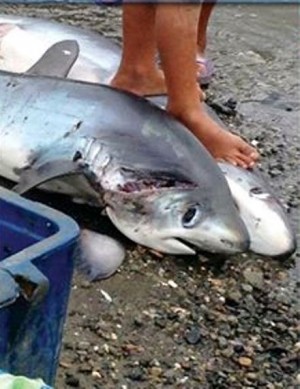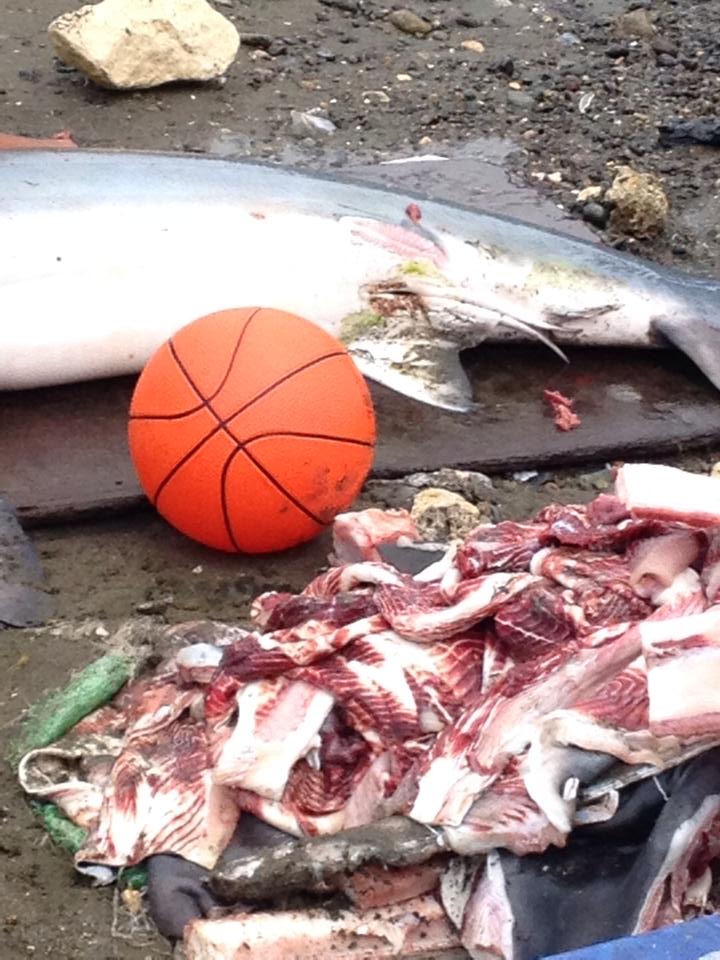Provincial Board seeks ban on hunting hammerhead sharks, transport of ‘samu’ seagrass

The bodies of sharks, cut up for sale, is widely traded in barangay Tangke, Talisay City. A resident took this photo of a thresher shark (left) being butchered and sold last month in sitio Magay, barangay Tangke even though its capture and sale are prohibited by a Cebu provincial ordinance. (CDN PHOTO/CONTRIBUTED)
If you want fresh shark meat, stroll along the shores of sitio Magay in barangay Tangke, Talisay City, and ask for “iho”.
Local fishermen offer it to wholesale traders who buy shark fins and meat at P50 per kilo.
“Why? Is that illegal?” one fisherman asked a curious visitor in Cebuano when no wares were displayed yesterday morning.
“No one told us it’s illegal. If it’s prohibited, we’ll stop hunting them,” said his companion, who joined a drinking spree after the day’s fish catch.
He said they’re lucky if they can catch a shark once a week, which they do using a hook and bait, but find it more frequently during January to April.
The capture and sale of thresher sharks, which are commonly found in Malapascua Island in north Cebu, has been banned since 2012 in a Cebu provincial ordinance, but the list is being expanded to other vulnerable species, like hammerhead sharks.
In yesterday’s Provincial Board session, PB Member Thadeo Ouano moved to amend Provincial Ordinance No. 2012-05 or the Provincial Fisheries and Aquatic Ordinance of Cebu to include three species of hammerhead sharks.
He took action after reading Cebu Daily News April 30 issue where the front page story “SHARK FOR SALE” showed the photo of a carcass of a young hammerhead shark on the tiled floor of the public market in Daanbantayan town in north Cebu.
The photo taken by a diver’s companion was posted on Facebook and disturbed other divers and environment advocates, especially since Malapascua is a world-known divers spot where thresher and hammerhead sharks can be readily seen underwater.
Just this year, three species of hammerhead sharks were included in the “red list” of the International Union for the Conservation of Nature (IUCN), which means their trade and transport require strict restrictions because the species are vulnerable to extinction.
Ouano said it was necessary to “update” the local law, since the Cebu province ordinance specifies the protection only of Thresher Sharks, Whale Sharks or “butanding” or “tuki”, Giant Manta Rays (“sanga”) and Sun Fish (“Mola Mola” as vulnerable species of fish.
Under this ordiance, it is illegal to “hunt, catch, possess, transport, sell, buy, distribute, wound or kill” these marine animals. Violators face a P5,000 fine or a maximum of l year in jail or both at the discretion of the court.
The PB yesterday approved Ouano’s amendatory ordinance on first reading.
He also proposed a ban on the transshipment or transport of brown seaweed or sargassum polycystum, locally known as “samu”, whose harvest is already prohibited in Cebu province.
The amendment was referred to Ouano’s committee on environment and natural resources, for more study and public consultation before it gets presented again for second and third reading.
“I was able to read the Cebu Daily News report on the hammerhead sharks. The Bureau of Fisheries and Aquatic Resources (BFAR) is requesting for the amendment of the ordinance so that they won’t have a problem in court. It was not covered in the original ordinance because hammerhead sharks are not common here,” Ouano said.
TALISAY MARKET
It’s not just Daanbantayan town where the sale of shark meat is happening.
After CDN’s story on the hammerhead shark saw print, a concerned resident in Talisay sent photos he took in April while strolling on the shores of sitio Magay in Talisay City. The images showed local fishermen skinning and mutilating captured sharks by the shore.

Local fishermen in Tangke, Talisay City skin captured sharks and wash the meat along the shore in this photo taken last month by a resident. (CDN PHOTO/ CONTRIBUTED)
The shark species was identified as a thresher shark when CDN sent the photo to Alessandro Ponzo, an Italian marine biologist conducting the Large Marine Vertebate Project – Philippines, a study which highlighted the whale sharks in Oslob.
Ponzo said hammerhead sharks, whale sharks, black tip sharks, manta rays and devil rays are commonly found in Cebu and the Visayas seas.
The rich variety, he said, is one good reason they should be protected and kept alive because “you can get the largest income from diving tourism.”
UNAWARE OF BAN
When CDN visited the shore of sitio Magay yesterday, local fishermen openly said they hunted sharks for higher income.
They didn’t know of any ban or that there were different types of sharks.
“Wala mi kabaw unsa to basta iho nga taas og ikog. Dili man sila mamaak. In ani gani og porma (We don’t know what kind of species but it’s a shark with a long tail and doesn’t bite. It looks like this),” he said, using his finger to draw a profile in the black beach sand.
Sitios Magay and Rattan in barangay Tangke are well known for their harvest of fresh large fish, as well as “iho”.
A tricycle driver guiding the CDN team, volunteered where to find the fishermen, saying sharks were being harvested almost daily.
But the fishermen said they would be “lucky” to catch sharks once a week.
At P50 a kilo, a juvenile shark that weighs 80 to 100 kilos can bring in P5,000 in one catch.
BAIT AND BEATING
The fishermen said they use a large hook with a bait and line. Once the shark bites, they pull it up and beat the animal until it gets weak before they put it in their small fishing boat.
A wholesaler then buys the entire shark, separates the fins, skins the shark and gets the meat. The head is cut off and given to the fishermen.
“It taste very good as long as you cook it with enough spices,” said one fisherman.
He said they stew it with tomatoes, garlic, onion and other spices to make “larang”.
They said they knew that catching whale sharks, which they call “tiki-tiki” is banned but didn’t know of other kinds of sharks.
Vince Cinches, Manila-based Oceans campaigner of Greenpeace Southeast Asia, said his group is calling for a moratorium on shark catching.
He said a scientific study has to be made about the shark population in the Philippines in order to legislate a nationwide ban.
“A lot of shark populations are dwindling or diminishing due to unregulated and unreported fishing.
Shark fishing is still very legal in the Philippines. That’s why it is important that a national legal framework to protect sharks should take place and be treated as urgent,” Cinches told Cebu Daily News.
Not all shark species are protected by CITES or IUCN although the Philippines is signatory to a lot of international agreements to protect vulnerable species.
“Sharks are apex predators and taking them out of the sea will further upset the already problematic status of our oceans,” Cinches said.
PB Ouano’s proposal will cover three species for protection – the Scalloped Hammerhead Shark(Sphyrna lewini), Squat-Headed or Great Hammerhead Shark(Sphyrna mokarran) and the Smooth Hammerhead Shark (Sphyrna zygaena .
The three are included in the IUCN “red list” as endangered or vulnerable.
As an endangered species under Article III of CITES, any transport of the scalloped or great hammerhead sharks requires an export permit from the State.
Starting this September, the scalloped hammerhead will be listed under Article II of Cites wherein trade will require the same export permit and only if the export will not be detrimental to the survival of the species.
Cites is focused on the trade of wildlife.
Related Story:
BFAR tells Daanbantayan: Stop shark trade
Disclaimer: The comments uploaded on this site do not necessarily represent or reflect the views of management and owner of Cebudailynews. We reserve the right to exclude comments that we deem to be inconsistent with our editorial standards.





